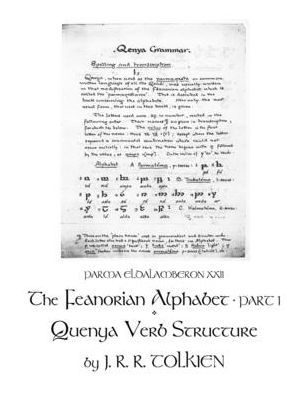Parma Eldalamberon 22: The Feanorian Alphabet, Part 1 & Quenya Verb Structure:
"The Feanorian Alphabet, Part 1" is a description of this writing system dating from the late 1930s. Four modes of use are described - Lindarin Qenya, Parmaqestarin, Old Noldorin, and Beleriandic. There are tables for each mode with the letters used and their names. Examples are given in tengwar with transcriptions. "Qenya Spelling" is the surviving portion of a contemporary Qenya Grammar. It describes the spelling of the written language in the Feanorian writing system and the transcription of its sounds in the Latin alphabet according to the usage of Ælfwine. Several short texts called "On Ælfwine's Spelling" date from the 1940s. "Quendian & Common Eldarin Verb Structure" describes the etymological background to the grammar of the Quenya verb and its prehistoric connections with the verbal systems of the other Elvish languages. The associated "Quenya Verbal System" describes the formation of the various tense stems and participles of the Quenya verb and their inflexions for number and voice. "Common Eldarin: Verb Structure" from approximately 1950 is a companion piece to "Common Eldarin: Noun Structure" published in Parma Eldalamberon, no. 21, both parts of a comparative grammar of the Eldarin languages. In the late 1960s Tolkien was planning a revision of these materials, and "Late Notes on Verb Structure" are texts dating from 1969, dealing with Tolkien's revised conceptions of verbal inflexion. Edited by Christopher Gilson and Arden R. Smith.
1146440769
Parma Eldalamberon 22: The Feanorian Alphabet, Part 1 & Quenya Verb Structure:
"The Feanorian Alphabet, Part 1" is a description of this writing system dating from the late 1930s. Four modes of use are described - Lindarin Qenya, Parmaqestarin, Old Noldorin, and Beleriandic. There are tables for each mode with the letters used and their names. Examples are given in tengwar with transcriptions. "Qenya Spelling" is the surviving portion of a contemporary Qenya Grammar. It describes the spelling of the written language in the Feanorian writing system and the transcription of its sounds in the Latin alphabet according to the usage of Ælfwine. Several short texts called "On Ælfwine's Spelling" date from the 1940s. "Quendian & Common Eldarin Verb Structure" describes the etymological background to the grammar of the Quenya verb and its prehistoric connections with the verbal systems of the other Elvish languages. The associated "Quenya Verbal System" describes the formation of the various tense stems and participles of the Quenya verb and their inflexions for number and voice. "Common Eldarin: Verb Structure" from approximately 1950 is a companion piece to "Common Eldarin: Noun Structure" published in Parma Eldalamberon, no. 21, both parts of a comparative grammar of the Eldarin languages. In the late 1960s Tolkien was planning a revision of these materials, and "Late Notes on Verb Structure" are texts dating from 1969, dealing with Tolkien's revised conceptions of verbal inflexion. Edited by Christopher Gilson and Arden R. Smith.
30.0
In Stock
5
1

Parma Eldalamberon 22: The Feanorian Alphabet, Part 1 & Quenya Verb Structure:
172
Parma Eldalamberon 22: The Feanorian Alphabet, Part 1 & Quenya Verb Structure:
172Paperback
$30.00
30.0
In Stock

Product Details
| ISBN-13: | 9798341801240 |
|---|---|
| Publisher: | Barnes & Noble Press |
| Publication date: | 10/18/2024 |
| Pages: | 172 |
| Product dimensions: | 8.50(w) x 11.00(h) x 0.37(d) |
About the Author

From the B&N Reads Blog
